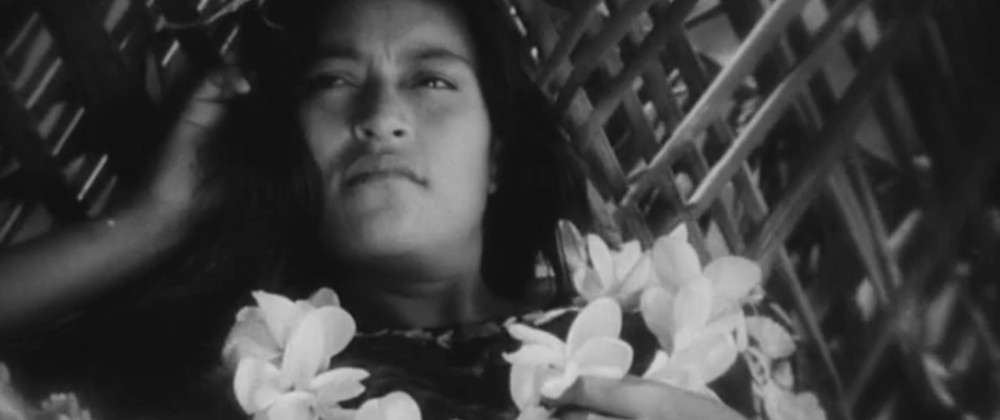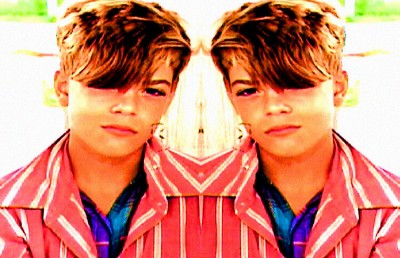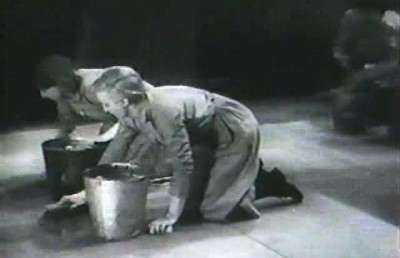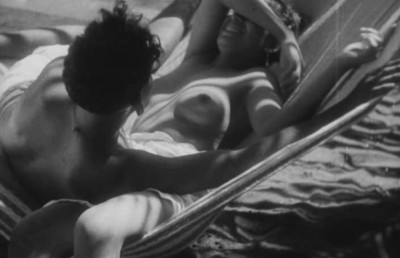Eisenstein’s Film-Symphony Project, Que viva Mexico! Part 1: Landscape
Eisenstein and Sound

After his failure to make his first sound film for Paramount in Hollywood, Eisenstein felt that he should try to make at least one film before returning home to Soviet Russia. In Los Angeles he approached the successful American socialist novelist Upton Sinclair for financial support for a film he wished to make about Mexico. Eisenstein had long had a fascination with this country. As a young man he had been intrigued by a series of photographs he had found in a German magazine, of the calavera, costumed skeletons from the Day of the Dead fiesta in Mexico City. From then on he felt a “desperate longing to see this in reality,” and not only this unique fiesta, but “the whole of a country that could take its amusements in such a way! Mexico!” (S.M. Eisenstein 1995, 411,412). The first theatre production he had directed was The Mexican (1921), adapted from a story by Jack London (Bergan 216-219). He had also designed the sets and costumes for it, using colours such as bright blue and yellow to evoke what he had imagined would be a Mexican atmosphere. He had met the famous Mexican painter Diego Rivera in Moscow, in 1927. Rivera was a guest of the Soviet government for the tenth anniversary celebrations of the Revolution. The charismatic painter had described to him the wealth and diversity of the cultures of his native land (Karetnikova 8). (*When Alexandrov introduces his version of Que viva Mexico! he mentions that the work of the Mexican muralists, in particular Diego Rivera, David Siqueiros and José Orozco had been their guides and teachers at the beginning of their film project). In addition Eisenstein read what he could find about Mexico, including D.H. Lawrence’s travel book Mornings in Mexico (1927) (Seton 257), and his novel The Plumed Serpent (1926), which he admitted that he could not finish (Eisenstein 1995, 361) perhaps partly because of Lawrence’s reactionary ideas at that time, which are a key part of this work.
Responding positively to Eisenstein’s request, Sinclair agreed to fund a film about Mexico. The director, his assistant Grigori Alexandrov and cameraman Eduard Tisse immediately set off to Mexico to start work, in December 1930. They were accompanied by Sinclair’s brother-in-law Hunter Kimbrough, who was to act as business manager for the production. They travelled the length and breadth of the country to research various aspects of Mexican life and culture, and the three-to-four-month schedule for filming which had been agreed with the Sinclairs soon elapsed. However when Sinclair saw what Eisenstein had filmed, he was delighted and he allowed him an extension to be able to complete his film. This extension also elapsed, whereupon Sinclair asked his brother-in-law to supervise Eisenstein’s filming more rigorously, so that he would know what the director and his assistants were doing, as well as to encourage them to complete the work. Kimbrough turned out to know even less about film than Upton Sinclair, and his complete lack of understanding of what was going on led to an irretrievable personality clash with Eisenstein, and ultimately to the director’s break with Sinclair. After thirteen months the film had gone considerably over budget and they had just one final episode of the film to shoot. At last Eisenstein had been able to secure the cooperation of the Mexican government, who were going to supply them with the hundreds of soldiers needed for this particular episode. At this point, to Eisenstein’s dismay, the novelist put a stop to his funding of the film. He kept everything that had been shot, and in spite of Eisenstein’s and others’ numerous efforts, over subsequent years Sinclair sold off the film to various individuals and companies who used it to make short features, travelogues and educational films. Eisenstein was never able to obtain a copy of his film to edit it as he had envisaged, and he never really recovered from its loss (Karetnikova 10,11,12, 15, 18, 19, 22, 28). In Mexico he had had complete artistic freedom. He had intended to make a new type of sound film, what he called a ‘Film-Symphony’ about his vision of the diversity and the destiny of a country which fascinated him, a film he called Que Viva Mexico!
He found in Mexico an intensity of colours resulting from the quality of light he encountered there. These saturated hues dazzled him, and again and again he made reference to this type of light in his memories of Mexico. This was part of what Eisenstein called ‘the Mexican fever’, caught by those who had been to that country. It evoked the hallucinatory “gold of the Mexican dawns and sunsets…the warm bronze of pensive faces…the dark green, bluish or light grey foliage…majolica on blue cupolas…the razor-edged green sail of the agave leaf…the flocks of parrots in shades of light green…” (Eisenstein 1995, 413,414,417) On several occasions he wrote about his experience when flying over the Gulf of Mexico: “the rose-coloured flamingos fly like arrows over the blue surface of the ocean between our airplane and the bronze-green Atlantic coast that lies at our feet.” (Eisenstein 1976, 382, Eisenstein 1995, 477). Eisenstein mentions the sensation of extreme heat, also part of the ‘Mexican fever’: from “the perpetually hot, dry heat of the desert” to “the hot embraces of the tropics” and “the searing heat” of the bullfight arenas (Eisenstein 1995, 417,418). The heat accentuates the sense of smell; Eisenstein recalled “the stupefying aroma of fermented maguey juice” from the pulque distillery, which permeated his sleeping quarters in the hacienda at Tetlapayac, his headquarters for the making of Que viva Mexico! (Eisenstein 1995, 11). The Mexican heat also helps to bring body and landscape together in other ways:
…in those moments at dawn or sunset, when the air is so transparent that it seems as if someone had stolen it, and distant slopes (of the) reddish mountains hang with blinding distinctness in the airless space between the ultramarine sky and the violet shadow of its own foothills – and suddenly you feel clearly that our eye cannot see, but feels and senses objects just as a blind man does with his hands. (Eisenstein 1976, 380,381).
In the intensity of Eisenstein’s experience of the twilight landscape his sight becomes like touch. He remembers the “emotional landscapes” painted on silk by Chinese artists of the eighth century, and realises that “images of a worldview” are not only present in the “flickering graphics of the brush” of Huang Ch’uan (Eisenstein 1976, 382), an artist from this period, but are there, in the actual Mexican landscapes, surrounding him everywhere. He quotes from Engels, where the philosopher refers to the religious beliefs and spiritual qualities of various kinds which he sees as growing directly from the specific character of the local landscape (Eisenstein 1976, 376,377,378). The interaction of the inhabitants with the tremendous variety of the Mexican landscape was to form a vital component of Eisenstein’s scenario for Que viva Mexico!
Que viva Mexico! and Landscape
Each section of Eisenstein’s scenario is based on a different Mexican landscape. The first part is a Prologue, a funeral set in Yucatan, amongst the Mayan ruins of vast pyramids and temples. Eisenstein filmed an “immobile procession,” symbolic of “a farewell rite to the ancient Maya civilization” (Karetnikova 39, 40). (*Alexandrov, in the Prologue in his version of Que viva Mexico! has a sequence of tableau-like shots of the funeral rite, and of single figures against the landscape of the Mayan ruins.) Some of the Mayan people he involved in the Prologue were chosen because of their physiognomic resemblance to the sculptures on the walls of the Mayan ruins. Even their poses and expressions are alike, so they blend and interact with the architecture in the landscape. The living people he shows become like sculptures and statues; Eisenstein planned to show a variety of groups of them as if they had joined the timeless ruins and had been turned to stone. He parallels the almost closed eyes of the living with the mask-like face of the dead man in the open casket. The only visual movement in this part of the film would have been scenes from various symbolic funerals, emerging from the original one, which would have appeared as “a shifting procession on the screen” (Karetnikova 40). This suggests a sequence of dissolves to blur the living with the dead, and various layers of the past with a present which already seems ancient. In this prologue static living figures would have emerged from the ancient human landscape of the Mayan ruins. (*The only possible exception is a shot which features human movement and which appears in Alexandrov’s version of Que viva Mexico! Eisenstein’s use of a Rodchenko-style shot, from an extremely low angle, makes the two men who are climbing the pyramid appear to blend with the architecture. This approach is a development of the Soviet Constructivist low angle shot, used to blend man with structures of the machine age.
After the Prologue there is a sequence of four stories. The first, titled Sandunga, is set in the tropical isthmus of Tehuantepec, and is named after a dance song which is the unofficial national anthem of the area. The story is very simple indeed. It features a Zapotec girl who is saving up for her dowry to marry her lover, and her subsequent early motherhood. It is a portrait of a matriarchal society, which still survives today (Fisher 446). Eisenstein uses this slim narrative to show the overwhelming abundance of life in the tropics: from the dense forests, to the flora and fauna who live freely in them. He portrays an idyllic existence, a paradise where the local ‘Tehuana’ girls (from the village of Tehuantepec) are described in terms of the tropical landscape. Their shining black hair is like a ‘cascade’ and they wear wreaths of flowers on their heads (Karetnikova 54). Lying in the shallow water of a river, they are juxtaposed with alligators basking in the sun. The young people seem to grow out of the landscape like flowers, in Eisenstein’s imagination their “beauty blossoms on the screen…” (Karetnikova 54). At the market in Tehuantepec he also notes the mixtures of cultures in this part of Mexico, lying at the narrowest point of the country between the Pacific and Atlantic oceans. The fruit, flower and fish stalls suggest India, the earthenware pots suggest Baghdad, and another aspect of the market evokes the South Seas. In the section showing a dance in the local hall, the tropical flowers, leaves and fruits become decorations for the festivities. After the dance the young man makes his proposal of marriage, and her acceptance sets in motion all the elements of a traditional wedding, including a banquet, elaborately decorated gifts, and girls dancing in their regional costumes. As the celebratory fireworks go off, following local traditions the young women turn their headgear inside out. Eisenstein compares them to a flock of ‘bih-birds’ spreading their wings (Karetnikova 55,56,57). The stills from this episode show the Tehuanas as if emerging from tropical vegetation, in a Gauguinesque way. Their clothes and what they carry feature floral and leaf designs, and when the young people’s torsos are naked, Eisenstein makes sure that the shadows from the tropical vegetation play on their skin. The Tehuantepec ‘romance’ began with a sunrise and the waking of the animal and human life inhabiting this lush landscape. It ends with a sunset as the diurnal animals retire, and we see the young mother, her young husband and their son, contented, totally integrated with the tropical landscape (Karetnikova 57). An alternative ending, also based on a total integration between people and landscape, features a transition to the next story through the shape and character of the Tehuana’s wedding dress: “the snowy white ‘weepeel’ – the mountain-like head-dress of the triumphant mother and wife. The snowy serenity. Snowy like the grey-haired Popocatepetl” (Eisenstein 1968, 198). The head-dress to volcano transition is shown in Eisenstein’s sketches for this breakdown of shots (Eisenstein 1968, 200). In these drawings he also shows further graphic match ideas using a triangular arrangement. The suggested progression of shots moves from cacti to sombrero, to a symmetrical montage within a single shot, of a man wearing a sombrero, with some cacti on both sides, and a volcano centered in the background. These transitions imply Eisenstein’s intention to evoke the complete integration of the human being with landscape.
The second story is in complete contrast, “as the North Pole differs from the Equator.” The landscape is harsh and consequently the people inhabiting it are austere, arrogant and aggressive (Karetnikova 76). All the action takes place on a high desert plain, at the foot of great volcanoes, in and around ‘the ancient Hacienda de Tetlapayac’, in the midst of ‘vast seas’ of the maguey cactus (Karetnikova 75,76). Once again the story begins around dawn, in this case some time before sunrise, and ends with the setting sun. The social structure is feudal, even though the action takes place at the beginning of the 20th century.
The owner of the hacienda has complete control over the lives of his workers, the peons, who go out daily to harvest the juice of the maguey cactus to make the ancient Indian alcoholic drink pulque. The feudal lord’s power even involves approving the brides of his workers (Karetnikova 77). Adhering to this tradition, the peon takes his bride to the landowner, an old man who simply gives a few coins to the young girl, and continues enjoying the annual fiesta of the hacienda which is in full swing. One of his guests drags the girl away and rapes her, while the peon is waiting outside for her to return. A servant tells him what has happened, so the peon attempts to rescue his bride, but he is thrown back out. Meanwhile the landowner, realising what has happened, decides to mask the incident by calling for the fiesta’s fireworks, music and games to begin. Outside, the peon decides to get his revenge for what has happened, and three other peons agree to support him. They try to set the hacienda on fire, and they steal arms and ammunition from the landowner’s armoury. They try to rescue the bride and are beaten back by gunfire from the charros, the cowboys from the hacienda. The peons flee and are discovered the next day. After another battle with the charros, during which the landowner’s daughter is shot dead, they are taken prisoner (Karetnikova 76,77,78,79). The peons are then buried up to their waists in the desert, and the charros ride over them, their horses’ hooves delivering the inevitable and final death blows (Seton, 505).
The massive sharp spikes of the maguey cactus are emblematic of the cruelty and violence of both this story and the harsh desert environment in which it unfolds. The aggressive forms of this cactus punctuate the stills from the episode. At one point, in their battle with the charros, the peons take refuge in a giant maguey cactus (Karetnikova 79). In other stills from later in the story, Eisenstein counterpoints the wounded head of the dead hero with a nearby scraggy and contorted cactus.
The third story is set during the same historical period as the Maguey episode and culturally it concentrates on the Spanish influences in Mexico. Like the previous two stories it ends at sunset, and the action takes place at various locations, which as a whole comprise an imaginary amalgam of the Spanish colonial style, from Mexico City, Merida, Taxco, Puebla, Cholula and other places representative of this architectural genre (Karetnikova 95). Like in the Sandunga episode the story is simple: a picador has an assignation with the wife of another man. Eisenstein uses this basic structure to show the various rituals before and during a bullfight, a huge national fiesta, the floating gardens of Xochimilco in Mexico City, and finally the summit of a mountain at sundown (Karetnikova 95,96,97,98). He shows how Christian and pre-Christian beliefs and rituals are interwoven in these events and places. At the centre of this episode is the annual fiesta in honour of Mexico’s patron saint, the holy Virgin of Guadalupe, on the 12th December. She is also the patron saint of the pre-Christian art of bullfighting, and the worship of the Virgin shares characteristics with rituals in honour of Tonantzin, a Mesoamerican mother-goddess (Caistor, et al, 109). The bullfighters in the story pray to her before they enter the arena. Eisenstein juxtaposes the Indian dancers getting their elaborate costumes and masks ready for their ritual dances, with the Catholic bishops and archbishops putting on their equally fine robes for their services (Karetnikova 96). Both types of ceremony are in honour of the Virgin of Guadalupe. After the bullfight the lovers take a boat through the floating gardens of Xochimilco, one of the few surviving sites built by the Aztecs in Mexico City (Caistor, et al, 113). The Spanish Baroque, the barroco, blending with equally complex Mesoamerican patterns are the key elements here. The decorated Spanish colonial architecture in the background, the elaborate moves of the bullfighters in their highly embroidered costumes, the intricate lace of the mantillas worn by the bullfight ‘belles’ in the audience, the religious robes of both Indians and Catholics, and the hundreds of festively adorned boats in Xochimilco, all make up what Eisenstein calls “the complex designs, the elaborate composition of this episode” (Karetnikova 95,96). The story’s main characters become lost in the colourful ‘moving maze of flower-covered floating temples of love’ in Xochimilco, the ‘so-called Venice of Mexico’ (Karetnikova 98). Intricate patterns dominate this episode, expressed in architecture, costumes, the movements of dancers and bullfighters, and the ancient man-made landscape of floating gardens.
The final story, like the Maguey episode, involves violence, in this instance during the Mexican Revolution. This part is entitled Soldadera, after the name given to the women in the vanguard of the revolutionary armies who prepare food in advance for the soldiers they ‘adopt.’ Against a background of a “tumultuous canvas of uninterrupted movements of armies, battles and military trains”, Eisenstein follows the nomadic life of Pancha, a soldadera whose adopted soldier dies in a battle, just after she has given birth. She and her baby are adopted by another soldier. Just when the next battle seems imminent, they are told that the civil war is over, and we see them celebrating the triumph of the Revolution with their former enemies, as they all begin a new life. Eisenstein lists the landscapes for this story: ‘deserts, woods, mountains and the Pacific Coast at Acapulco, Cuautla and Morelos.’ The soldadera trudge on dusty roads, and at one point Pancha is lost from view “in the big moving mass of humanity” veiled by the dust. They also travel on the roof of a troop train, where they are ‘squatted like crows.’ Eisenstein describes how, during a battle, the soldadera take refuge beneath the cars of a freight train and hang their holy icons from the car wheel, as well as their “little votive lamps on the springs of the car axle.” In this revolutionary context, unlike during the Russian Revolution, there is no attempt to forego religious devotion (Karetnikova 128,129,130,131,132).
The Epilogue is set in modern Mexico, and Eisenstein begins with a parade of modern industries. He shows current leaders, including generals, engineers and aviators, to demonstrate that in Mexico there is an equivalent to the process of industrialisation of the Soviet Union (Karetnikova 137, 138). Here Eisenstein’s description of large scale industry brings to mind the world of Vertov’s Enthusiasm. Agriculture is also being developed. Then he begins to focus on the people’s faces. As in an epic mural by Diego Rivera, Eisenstein shows us how these modern faces are identical to the ones we have seen in all the previous episodes, including at the immobile funeral lost in the depthless time of Yucatan, from the Prologue at the very start of Que viva Mexico! The film ends as it began, with the theme of death. To conclude, Eisenstein shows us the Calavera, the Mexican fiesta for the Day of the Dead. This is when, starting on the eve of All Saints’ Day, the dead make their annual visit to the world of the living. Dancing skeletons appear, dressed in a variety of costumes, representing the dead from all levels of Mexican society, from the president, the leaders of the military, the feudal landowners down to their peons, the soldadera and others whose lives we have witnessed in the previous episodes. The film ends on the image of a smiling boy’s face which fills the screen, after he has removed his skull mask. He personifies ‘the new growing Mexico,’ the ‘victory of life over death’, the idea which lies at the centre of the fiesta of the Day of the Dead (Karetnikova 149, Seton 509,510,511).
Bibliography
Bergan, Ronald. 1999. Sergei Eisenstein: A Life in Conflict (Woodstock, New York: The Overlook Press).
Caistor, Nick, Maria Doulton, Petra Fischer, et al. 1999. Mexico (London, Dorling Kindersley).
Eisenstein, S.M. 1968. The Film Sense, trans. and ed. by Jay Leyda (London: Faber and Faber Limited).
Eisenstein, S.M. 1976. Nonindifferent Nature, trans. by Herbert Marshall (Cambridge: Cambridge University Press).
Eisenstein, S.M. 1995. Selected Works. Beyond the Stars: The Memoirs of Sergei Eisenstein, ed. by Richard Taylor, trans. by William Powell. 4 vols (London: BFI Publishing and Calcutta,
Seagull Books Private Limited), IV.
Fisher, John. 1999. Mexico: The Rough Guide (London: Penguin Books Ltd.).
Karetnikova, Inga, in collaboration with Leon Steinmetz. 1991. Mexico According to Eisenstein (Albuquerque: University of New Mexico Press).
Seton, Marie. 1952. Sergei M.Eisenstein: A Biography (New York: A.A. Wyn, Inc.).













